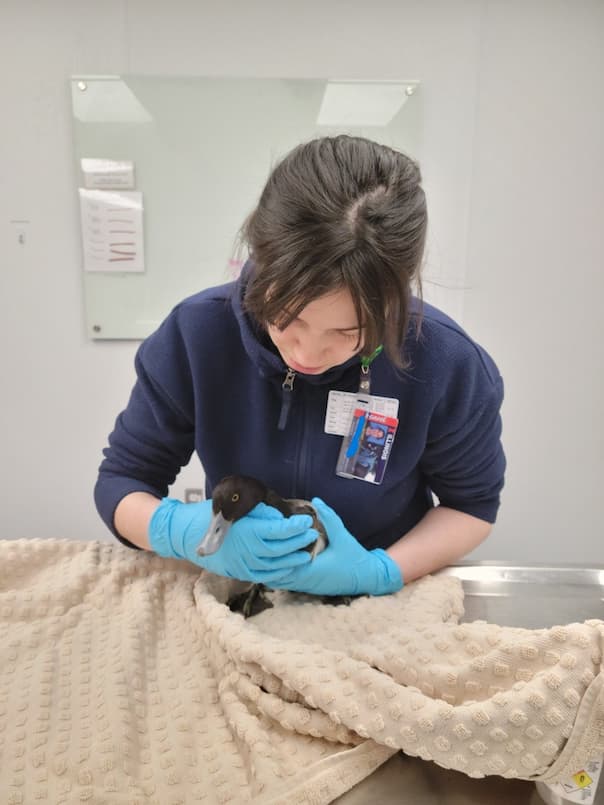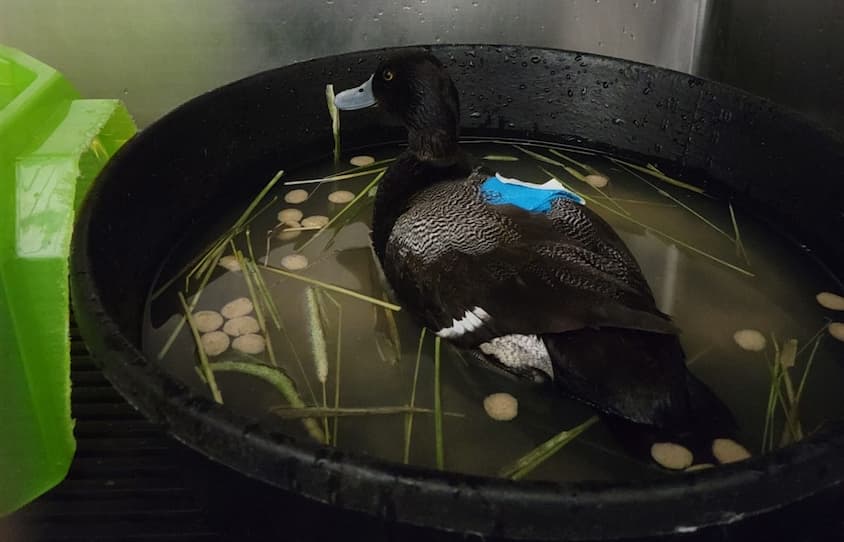On February 28, 2023, an adult male lesser scaup presented to the Wildlife Medical Clinic. This is a type of duck, and they are sexually dimorphic, meaning the males and females do not look the same. Males have black and white feathers and a blue bill, whereas the females have more brownish colored feathering and a white patch next to their black bill. They typically migrate from Central America, Mexico, the Caribbean, and the southern United States to the Northwest United States and Canada. The spring migration begins in February, so we believe that this patient was passing through Illinois on his way north. Our initial goals were to rehabilitate him as quickly as we could so we could reunite him with his flock on their way north to their summer home. Lesser scaups are diving ducks and like to spend most of their time on the water. They will dive in waters less than 16 feet deep, using their feet to propel them as they forage for prey.

During his physical exam, we appreciated an injury in the right shoulder. We suspected that the injury was due to a traumatic event. The exam showed no other abnormalities, which meant the patient was otherwise healthy. To stabilize our patient and prevent further injury until one of our veterinarians could examine him, we placed a bandage to secure the wing to the body. We were hopeful that the injury was one that could be healed and eventually allow our patient to regain full flying capabilities.
In a few days, the patient was anesthetized to obtain radiographs (x-rays), and sadly we found that the injury was severe and could not be corrected well enough for this bird to ever regain normal flight.
This was a difficult case that I struggled with, because of course I became interested in veterinary medicine to rehabilitate injured animals. My experience prior to working in the Wildlife Medical Clinic had been primarily with domestic animals, but the goals are completely different when working with wildlife. When working with domestic animals, our goal may simply be to provide a comfortable quality of life in the care of their owners. Wildlife, however, need to be indistinguishable from other members of their species, as they need to be functioning optimally to ensure their survival in the wild. After we release them, wildlife need to migrate, find food, evade predators, mate, and raise offspring. We can’t provide them with life-long medications, or have them return later in life for recheck exams. Any animal that cannot perform these functions would not survive in the wild, and many chronically injured wild animals would not be suitable for a life in captivity. These high standards are what makes wildlife rehabilitation so difficult.

At the end of our journey with our patient, we were still able to help end his pain and suffering. As veterinary students and veterinarians, we are responsible for making the most informed decisions for our patients, no matter how difficult they may be. I am grateful that I learned this valuable lesson as a student in the Wildlife Medical Clinic. While the outcome wasn’t what I hoped for, it was still the best outcome for this individual and helped me to learn and grow in my journey to becoming a veterinarian.
Written by Sofia, Class of 2026

